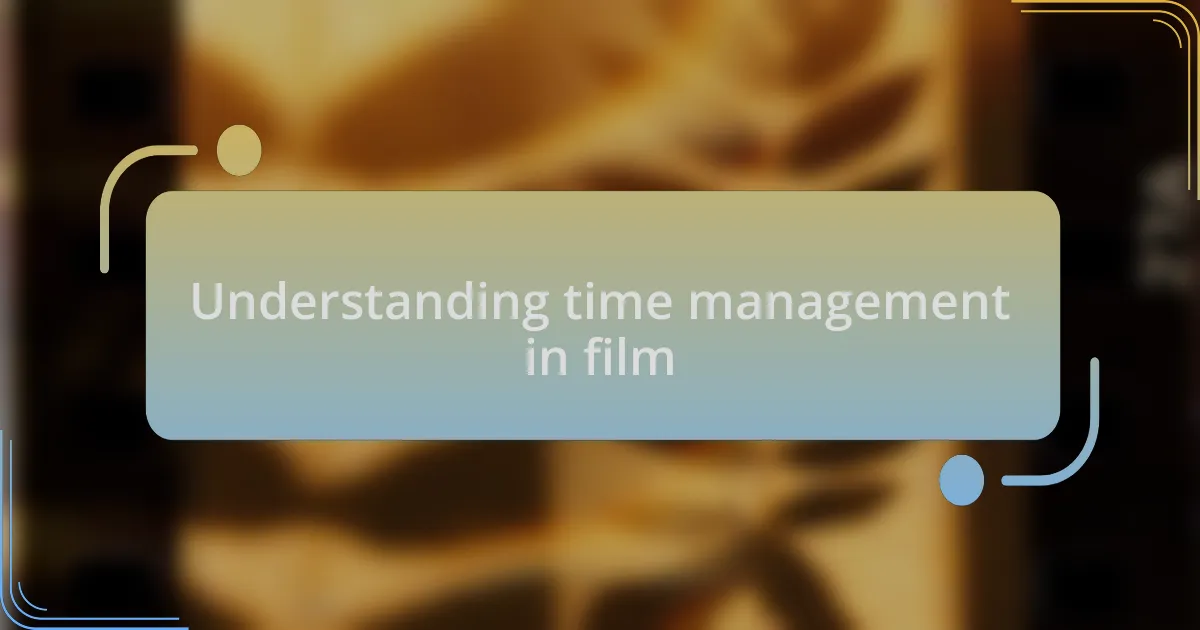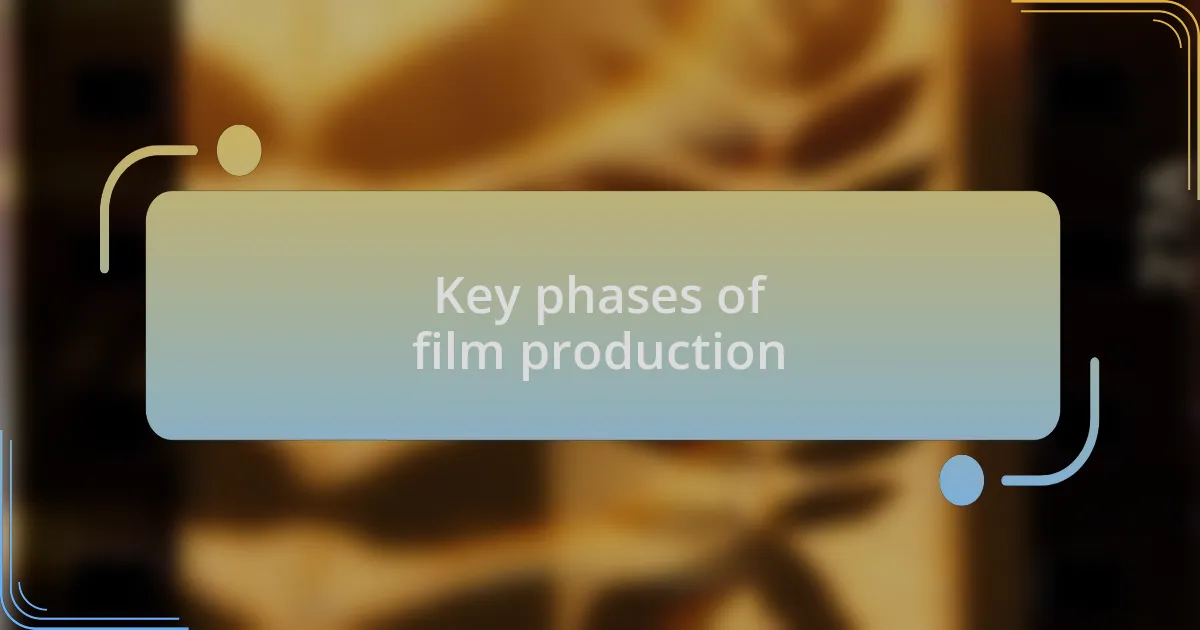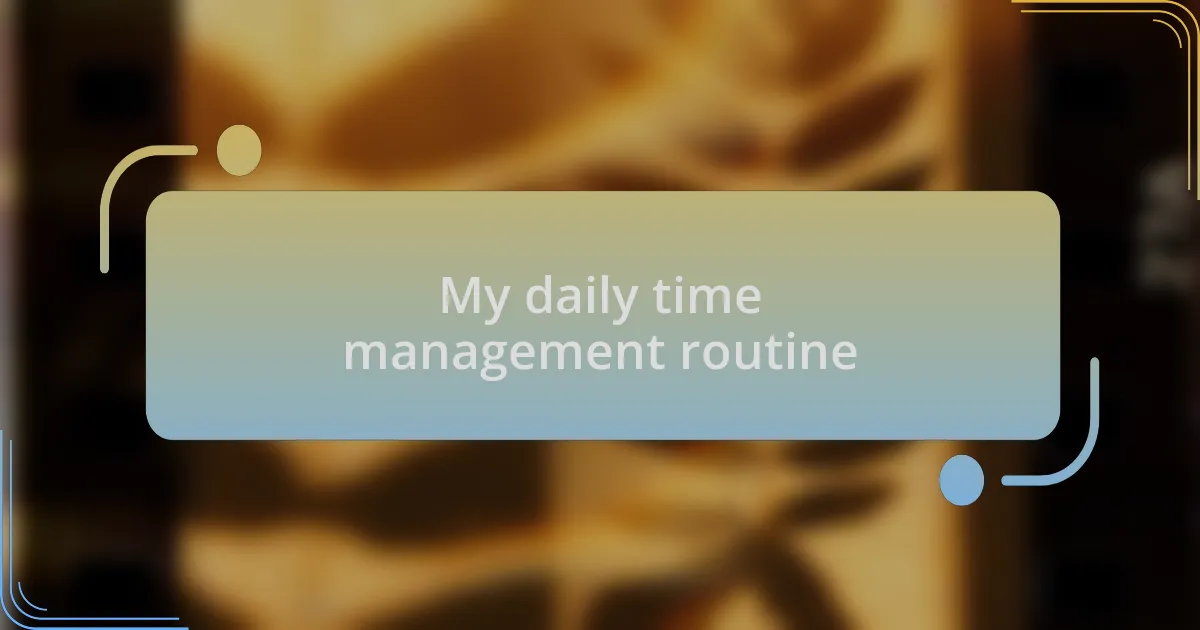Key takeaways:
- Time management in film balances creativity and deadlines, requiring structured timelines and flexibility to adapt to unforeseen challenges.
- The film production process consists of three key phases: pre-production, production, and post-production, each demanding effective time management to ensure success.
- Utilizing software tools and traditional methods, like calendars and whiteboards, aids in tracking project time and enhancing team collaboration.
- Balancing creativity with deadlines can be achieved by setting mini-deadlines and dedicating focused hours for brainstorming, fostering both urgency and artistic flow.

Understanding time management in film
Time management in film is more than just sticking to a schedule; it’s about balancing creativity with deadlines. When I was part of a short film project, I found myself often torn between the urge to refine a scene and the reality of our shooting schedule. How many times have you felt that tug-of-war between artistry and time constraints?
In my experience, a well-structured timeline can be your best friend on set. During one hectic weekend shoot, I implemented a detailed call sheet, breaking down each segment of the day. This not only kept the crew focused but also allowed us to handle unforeseen delays without losing our grip on the overall schedule. There’s a certain relief that comes from knowing everyone is on the same page, isn’t there?
Another key aspect is flexibility. I learned that while it’s crucial to have a plan, sometimes you need to adapt on the fly. Once, an unexpected rainstorm forced us to shift our shooting location. Instead of panicking, our team quickly devised an alternative, utilizing the unique constraints to enhance our story. It’s moments like these that remind you of the inherent unpredictability of film production, and how adaptability can turn potential setbacks into creative opportunities.

Key phases of film production
The film production process typically unfolds in several key phases: pre-production, production, and post-production. During pre-production, I found that thorough planning sets the foundation for everything that follows. For instance, I vividly remember collaborating with a production designer who meticulously created storyboards, and it made me realize how these visual maps can transform a creative vision into tangible steps that guide the shoot.
Once we entered the production phase, the pace picked up dramatically. I can still recall the adrenaline rush of our first day on set. Despite the chaos, the camaraderie among the cast and crew was palpable. We had to make quick decisions, whether it was accommodating an actor’s impromptu change or brainstorming how to shoot a scene under tight time constraints. Did you ever notice how a single moment of inspiration can pivot an entire shoot?
Finally, in post-production, I learned that time management is just as critical, albeit in a different way. Editing can be an all-consuming process, and I often had to remind myself to step back and keep the bigger picture in mind. I remember feeling the weight of the final cut in my hands, knowing every edit could enhance or alter the intended message. This phase reinforced the idea that managing time effectively is essential at every stage, allowing the film to evolve while still meeting deadlines.
![]()
Tools for tracking project time
When it comes to tracking project time, I’ve found that utilizing software tools can significantly simplify the process. For example, during a recent documentary shoot, I relied heavily on project management software like Asana to keep our tasks organized and visible. It’s impressive how a central platform can offer timelines and reminders that help ensure everyone stays on the same page, especially when juggling multiple shoots and locations.
In addition to software, I’ve also turned to time-tracking apps like Toggl to log hours spent on various tasks. I remember feeling particularly challenged during a longer editing session; with Toggl, I could see exactly how much time I was investing in each segment of the film. This not only allowed me to manage my time better but also provided insights for future projects. Have you ever experienced that gratifying moment when you realize that you’re making progress by simply keeping an accurate record?
Moreover, using a physical calendar or whiteboard can complement digital tools wonderfully. I once put up a giant whiteboard in my workspace, divided into weeks dedicated to different phases of production. It was quite a visual representation of our progress, and every checkmark felt like a mini victory. The tactile element of physically marking tasks as completed brought a sense of accomplishment I didn’t expect, showing me that sometimes old-school methods can enhance the modern techniques we rely on.

My daily time management routine
To manage my time effectively during productions, I developed a daily routine that blends structure with flexibility. Each morning, I start by outlining my top three priorities for the day. It’s surprising how focusing on just a few key tasks can create a sense of achievement and direction. Have you ever noticed how accomplishing even small goals can boost your motivation for the rest of the day? I certainly have.
I typically allocate specific blocks of time for different tasks, like pre-production planning, filming, and editing. For instance, I often dedicate the early hours to script reviews when my mind is fresh. This peak time allows me to concentrate fully, without distractions. I remember a day when I managed to finalize a difficult script in just a couple of hours, and that sense of clarity really kick-started my creativity for the rest of the project.
In the afternoons, I reserve time for meetings. I find that meeting in the later part of the day helps keep everyone engaged, as we can recap the progress made earlier. It’s interesting how face time with the crew can create a collaborative atmosphere where ideas flow freely. Sometimes, I leave those meetings pleasantly surprised by the innovative solutions we create together, reminding me how essential teamwork is in film production.

Balancing creativity and deadlines
Working in film production means constantly juggling creativity with deadlines. I remember one critical project where I had an entire week to secure a perfect shot but felt the pressure creeping in. Balancing artistic vision with the ticking clock wasn’t easy, and it made me wonder: how can we stay true to our creative instincts without compromising on time? For me, the answer was dedicating focused hours to brainstorm freely, allowing creativity to flow without the weight of a deadline looming over my shoulder.
During those brainstorming sessions, I also set mini-deadlines to cultivate both a sense of urgency and creativity. For instance, I once challenged myself to generate five unique concepts for a scene within an hour. That little push ignited a rush of ideas I might not have accessed otherwise, proving that a bit of pressure can be a catalyst for creativity. Have you ever found that small constraints can actually enhance your imaginative output?
As I wrap up my projects, I take time to reflect on what worked and what didn’t. There was a moment when I finally marveled at how everything came together seamlessly, despite the time constraints. It reminded me that the balance between creativity and deadlines is not just a struggle but an intricate dance, one that can lead to some of the most fulfilling moments in filmmaking.